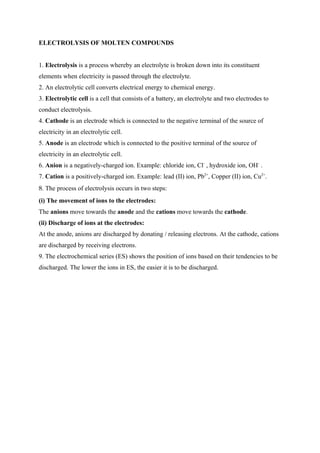Electrolysis of molten compounds
•Als DOC, PDF herunterladen•
0 gefällt mir•2,494 views
Electrolysis is a process where an electrolyte is broken down into its constituent elements when electricity passes through. An electrolytic cell converts electrical energy to chemical energy using a battery, electrolyte, and two electrodes. During electrolysis, anions move toward the anode and cations move toward the cathode, where they are discharged by gaining or losing electrons.
Melden
Teilen
Melden
Teilen

Empfohlen
Empfohlen
Weitere ähnliche Inhalte
Was ist angesagt?
Was ist angesagt? (20)
Andere mochten auch
Andere mochten auch (18)
Ähnlich wie Electrolysis of molten compounds
Ähnlich wie Electrolysis of molten compounds (20)
presentation_electrochemistry_part_i_1651145702_423484.pdf

presentation_electrochemistry_part_i_1651145702_423484.pdf
Electrolysis of molten compounds
- 1. ELECTROLYSIS OF MOLTEN COMPOUNDS 1. Electrolysis is a process whereby an electrolyte is broken down into its constituent elements when electricity is passed through the electrolyte. 2. An electrolytic cell converts electrical energy to chemical energy. 3. Electrolytic cell is a cell that consists of a battery, an electrolyte and two electrodes to conduct electrolysis. 4. Cathode is an electrode which is connected to the negative terminal of the source of electricity in an electrolytic cell. 5. Anode is an electrode which is connected to the positive terminal of the source of electricity in an electrolytic cell. 6. Anion is a negatively-charged ion. Example: chloride ion, Cl- , hydroxide ion, OH- . 7. Cation is a positively-charged ion. Example: lead (II) ion, Pb2+, Copper (II) ion, Cu2+. 8. The process of electrolysis occurs in two steps: (i) The movement of ions to the electrodes: The anions move towards the anode and the cations move towards the cathode. (ii) Discharge of ions at the electrodes: At the anode, anions are discharged by donating / releasing electrons. At the cathode, cations are discharged by receiving electrons. 9. The electrochemical series (ES) shows the position of ions based on their tendencies to be discharged. The lower the ions in ES, the easier it is to be discharged.